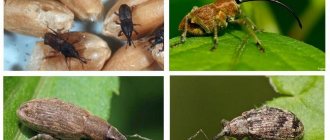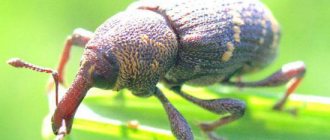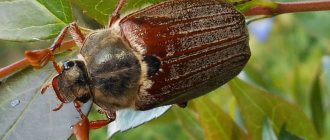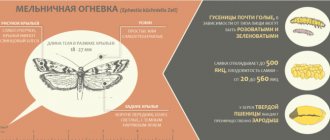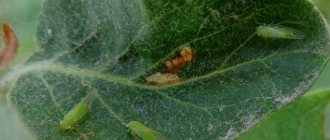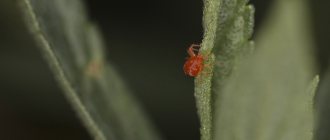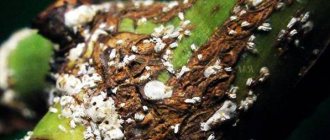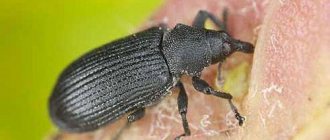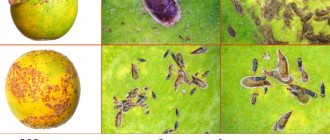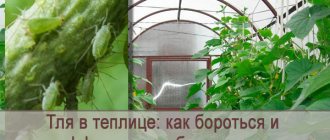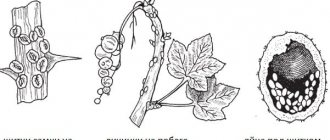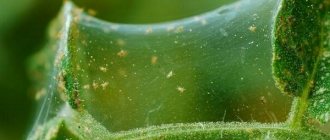Author: Elena N. https://floristics.info/ru/index.php?option=com_contact&view=contact&id=19 Category: Plant Pests Published: December 27, 2016Last edits: October 28, 2020
- Weevil on strawberry
The weevil (lat. Curcullionidae), or elephant beetle, belongs to one of the largest families, numbering more than 70,000 species, and most of them inhabit the tropics. About 5,000 species of weevils live in the middle zone. The weevil insect is a plant pest, and each species has its own preferences - one variety damages forest plants, another vegetable, a third garden, a fourth variety of beetle damages the growing point of a palm tree, as a result of which the plant dies.
Description
Weevils range in length from 1 to 30 mm, while tropical species grow up to 5 cm in length. The body shape of beetles of this genus can be flat and oblong, cylindrical, rod-shaped, rhombic, spherical, convex hemispherical or pear-shaped. The color varies from yellow to black, there may be spots on the body, and it may have a metallic tint. The insect's legs may differ in color from the body.
The upper part of the weevil's body may be hairy or bare, and may be covered with an earthen crust or glazed brown scales. A characteristic feature of the insect is the elongated front part of the head - the rostrum, from which the genus of insects got its name.
Weevils are divided into two subspecies - short-proboscis and long-proboscis, differing from each other in the length of the rostrum. The larvae of long-proboscis species usually develop in plant tissues, consuming them as food, while the larvae of short-proboscis species live in the soil, feeding on plant roots.
- Thrips: how to fight on indoor plants and in the garden
Weevils living in the middle zone prefer to live on berry crops, and they are attracted not by fruits, but by flower buds in which the female lays eggs. The larvae that emerge from the eggs eat the flower from the inside, and if there are a lot of weevils, you may not get any berries at all. However, there are also types of weevils such as house weevils and barn weevils.
Weevil: what harm does it cause to plants?
This type of beetle reproduces directly in flower buds. There they lay their larvae, and they, in turn, eat the plant from the inside when they reach maturity.
Adults eat leaves along the edges, causing direct damage to the plant. In addition to leaves, they love to feast on buds. Ultimately, the flower buds are unable to open due to the larvae inside and naturally die. In the soil, they eat the roots, and the plant cannot live long from such damage.
Barn weevil
The barn weevil is a small dark brown bug about 4 mm long with underdeveloped wings. This is a dangerous pest of grain crops. Moreover, archaeologists have established that it has been engaged in its destructive activities for a long time: in the 20th century, scientists discovered traces of the weevil in excavations of ancient Egyptian burials, and in Ancient Rome the insect was known as a pest called Curculio. An adult insect damages grain and products made from it, and larvae from eggs, which the female can lay up to 300 eggs in one clutch, develop in the grains of millet, wheat, rice (rice weevil), oats, barley, buckwheat, and rye.
The weevil also lives in flour and pasta. Grain infected with weevil larvae becomes unusable, causing digestive disorders in people, as it becomes hygroscopic, heats up on its own and rots.
Damage caused by pest
Bugs, which many seem cute because of the bizarre structure of the front part, can cause a lot of problems for owners of suburban areas. Of course, there are insects that are more voracious and dangerous, but weevils are also capable of destroying most of the crop. Among the variety of species of elephants (as pests are popularly called), there are those that prefer fruit and forest trees, those that feed on stored grain and flour, and lovers of berry crops, and connoisseurs of growing cereals, legumes, herbs and nuts, and those who use food house plants.
- If fruit weevils have settled in the garden, the apple, pear and plum trees are primarily at risk. But other types of trees and shrubs are also at risk: cherry, peach, cherry plum, quince and other garden trees and shrubs.
Pests that appear on the site first of all pay attention to the buds of plants.
The beetles pierce them with their proboscis, as evidenced by the drops of juice that appear. As a result, the buds turn brown and begin to fall off. In some cases, leaves and inflorescences still develop from them, but they can no longer become full-fledged. In buds and blossoming flowers, weevils eat away the leaf and generative parts. While the perianth has not unfurled, the pests gnaw a small hole in the bud and lay an egg in it. The emerging face feeds on all parts of the bud and leaves its waste products in it. As a result, the flower does not bloom, it turns brown and dries. The dots on the bud should prompt the gardener to take immediate action to eliminate the parasite. The beetle that emerges from the pupa eats the remaining flowers and does not disdain the young shoots of the fruit tree and foliage. As a result of damage by weevils, plant leaves become brown, begin to wither and crumble. This shedding of foliage can usually be observed in the first half of June. Large colonies of pests can cause defoliation of almost all fruit trees. Dropping leaves greatly weakens garden crops, leading to a decrease in the growth of new branches and the formation of fruits. Moreover, the impact of insects destroys not only the current season’s crop, but also has a detrimental effect on the formation of next year’s buds. Some species of weevils use set fruits to lay eggs. This usually happens in June-July.
The hatched larva develops by eating stalks, fruit pulp and seeds. As a result, part of the crop falls to the ground. During the years of abundant fruiting of garden trees, the damage caused by the weevil to the crop can be assessed as insignificant, since, by and large, excess ovaries are destroyed. But if the flowering of fruit crops is weak, you may not get any fruit at all. Weevil larvae that hatch from eggs laid by females in the soil can cause serious damage to the root system of plants. Fruit bark beetles, or more precisely, their larvae, are capable of gnawing tunnels in the bark of garden trees, which leads to drying out of plants.
- Many owners of houses, apartments or warehouses from time to time find small bugs in their stocks of cereals, beans or flour. Barn weevils are the most common type of such pest. Insects are able to damage stored products in a short period of time, which can no longer be used as food.
Pests enter the house along with products purchased in a store or market. It is quite difficult to immediately detect them, because the grains in which the female has laid eggs are sealed with her mucus. The hatched larvae are almost impossible to notice in the flour with which they merge, but in nuts or buckwheat the parasites are quite visible. Barn weevils, nut weevils, rice weevils, or oak weevils can live indoors. They not only spoil bulk products, but a composition is released from the glands of insects, the unpleasant odor of which is transferred to the products. Pest waste can cause allergic reactions in people that are hazardous to health. Excretions and particles of chitinous cover that get into food lead to infection of the body and disruptions in the gastrointestinal tract. In addition, beetles carry fungi, bacteria and other types of pathogenic microorganisms. Measures to destroy weevils indoors should be taken immediately, preventing them from multiplying.
- Beetles also do not ignore beds with berry crops. If they appear in the garden, you can lose half the harvest.
As a result of the invisible activity of weevils, seedlings wither, buds are damaged and fall off, berry ovaries die, and leaves dry out. Elephants gnaw the mustache of wild strawberries and strawberries, damaging the root system. Voracious insects are often not limited to berry bushes; they also move to other plants. They can quickly spread to neighboring areas, which greatly complicates pest control. Also, various types of elephant beetles can cause serious damage to tuber and legume crops, vegetables and industrial plants, grapes and ornamental plantings.
House weevil
The weevil in the apartment is the same granary weevil in the grain, which gets into the apartment along with the purchased cereal. The female lays each egg in a cave gnawed out in the grain and seals the hole with her secretions. There, after 6-12 days, a larva emerges from the egg, which feeds on the inside of the grain, and then gnaws through its shell and comes out. How to get rid of weevils in grain? It is difficult to combat the pest precisely because the larva cannot be detected while it is in the grain, and yet there are ways to combat the weevil.
Classification and varieties
There are more than 100 thousand varieties of weevils, and new species are discovered every year.
Beetroot
This type of weevil lives almost throughout the entire territory of the Russian Federation, except for the Far Eastern Territory.
Description:
- The size of the adult and larvae is 12 mm.
- The head is thick with a short proboscis.
- The body is covered with thick dark hair and gray stubble.
- The elytra have tubercles in the upper part, the hind wings are not developed.
The beet weevil feeds on beets, wild beans, corn, and sunflowers.
Southern gray
The most common type of weevil, it lives in the Caucasus, Krasnodar Territory, Moldova, and the south and west of Ukraine.
Description:
- The length of an adult is 6-8 mm. The size of the larva is 1 cm.
- The color of the scales is gray-brown, the color of the larvae is whitish-yellow.
- The head and proboscis are short, massive, and have wings.
- In early spring they feed on shoots of winter crops, then fly to spring fields.
The southern gray weevil harms corn, beets, sunflowers, and tobacco.
Rice
This type of insect lives mainly in the southern regions.
Description:
- The size of the adult and larvae is 2-3.5 mm.
- The rostrum is short.
- Color – dark brown or black-brown, scales matte. There are 2 red spots on the rough elytra. The color of the larvae is white.
- Beetles can fly.
- Lives in barns. Sometimes it crawls into fields that are located near storage facilities.
- Females lay eggs inside the seeds, and the hole is sealed with a plug made from their own secretions.
- The pest forms a hidden form of infection.
- The beetle is a heat-loving insect. At temperatures below +13, humidity less than 10%, the rice weevil does not develop.
The rice weevil damages grains of wheat, rye, corn, rice, and barley. It can live in flour, beans, pearl barley, and dry dairy products.
Important! The rice weevil is very harmful. When infected, cereal crops lose up to 75% in weight.
fruit
This species of weevil is not registered in the Russian Federation.
Description:
- The adult size is 6-7 mm, the rostrum is a quarter of the body length.
- The body is covered with a thick scaly cover. The color of the scales ranges from dark brown to steel. The color of the larva is grayish-white.
- For wintering, they migrate from gardens and settle in the upper layers of the soil, in wood processing enterprises.
- The exit from wintering coincides with the flowering time of apple trees.
- After wintering, weevils feed on buds, petals, young leaves and shoots, and then on fruit pulp. Females lay eggs under the skin.
- The larvae penetrate deep into the fruit. Infected berries and fruits fall off.
The beetle is a pest of berries, various fruits, and ornamental crops.
Raspberry-strawberry
The raspberry flower beetle is one of the most common pests and lives almost throughout the entire territory of the Russian Federation.
Description:
- The size of an adult is 2 mm.
- The beetle is completely covered with small hairs and colored black. The color of the larva is grayish-white.
- They overwinter in the ground and come to the surface when the temperature rises to +13 degrees.
- Weevils first feed on growing leaves, then on anthers.
- The female lays larvae in the buds. It gnaws at the base of the peduncle, and the dried bud soon falls off.
The raspberry flower beetle harms blackberries, roses, apple trees, and strawberries. Larvae and adults cause harm.
Effective measures to combat the raspberry-strawberry weevil on raspberries
Strawberry plantings often suffer from nettle leaf weevil. The bright green beetle infects buds, young leaves, and the root system of plants.
Important! The strawberry weevil is less likely to attack plants with female inflorescences - underdeveloped stamens provide less food for the larvae.
Pine
The large pine weevil feeds mainly on coniferous trees. But beetles can often be found on grapevines, cherry plum leaves, in apple orchards, plums and other fruit crops.
Description:
- The length of the beetle is 10-14 mm.
- Color – dark brown, black. The wings have curved yellow stripes.
- The larva is curved, yellowish-white, 11-15 mm long.
- They leave wintering grounds at the end of April.
- They fly well.
- Active in the evening and at night, during the day they hide in cracks in the bark.
- Beetles feed on the bark, shoots, and buds of trees.
Habitat: Northern, Central Europe, Caucasus, Siberia, Japan.
Rough or turnip
The rough mower, or turnip mower, is widespread everywhere - in the northern and southern regions.
Description:
- The beetle is oval in shape, size – 7 mm.
- On the back there are sparse hairs, yellowish scales, and raised tubercles.
- The proboscis is short.
- Larvae feed on roots, adults feed on tops and buds.
- The mower damages various vegetable and fruit crops.
- The pest is most active in cloudy weather.
Important! If you touch the rough weevil, it falls and pretends to be dead.
Alfalfa
The natural habitat of the alfalfa leaf weevil is the North Caucasus and the Volga region.
Description:
- The adult size is 5.5 mm, the larvae are 9 mm.
- The color of the weevil is green; there are gray-brown dark spots on the elytra. The color of the larvae is greenish, with a longitudinal yellow stripe along the entire body and a brown head.
- The head is thick, on the upper part of the back there are 3 longitudinal light stripes.
The beetles feed only on alfalfa - the damaged plant quickly turns gray and dries. They overwinter in the soil of alfalfa fields.
Furrowed
The grooved weevil, or solitary weevil, is a common pest. Sometimes it even affects indoor plants after they are kept outdoors in the summer.
Description:
- Length – 8-10 mm.
- The color is black, with deep dotted barbs on the elytra. The larvae are white with a brown head.
- A single mower cannot fly.
- Weevils are nocturnal and hide in the substrate during the day. When touched, they become numb, fall, and merge with the soil.
- They damage the leaves and root system of plants.
Rhododendrons are most often affected by the grooved weevil.
Small black
The beetle lives in the steppe and southern regions of the forest-steppe.
Description:
- The size of an adult is 6-10 mm, larvae are 12-16 mm.
- The surface of the body is black, shiny, the abdomen is covered with light gray fluff.
- There are no wings.
- The rostrum is short and wide.
- Pests overwinter in the soil, at a depth of 25-45 cm. They come to the surface in April, when the temperature rises to +7-9 degrees.
- At night and in cool weather they move to the top layer of soil.
- Weevils feed on young leaves and shoots.
The black weevil harms more than 130 plant species. Most often, beets, sunflowers, cabbage, strawberries, and legumes suffer from the pest.
How to get rid of weevils
Ways to fight
This dangerous and polyphagous pest must be combated with all available means - preventive, physical-mechanical, chemical, biological and folk.
As a preventive measure, before receiving and placing grain, you should disinfect storage facilities from the granary weevil - wet or aerosol, and then treat the grain - dry it, clean it of debris, cool it as much as possible and, if necessary, treat it with contact insecticides.
- Miner / Mine
In summer cottages where other types of pests are common, for preventive purposes they use loosening the tree trunks, removing fallen leaves, dry and diseased branches, plant pest-repellent crops in the rows, carry out preventive treatment of plants with the biological preparation Fitoverm, attract birds to the area by hanging birdhouses and nest boxes for trees, and when weevils appear before mating and laying eggs, they are collected by hand or shaken off onto a thick cloth spread under trees or bushes, after which the pests are destroyed.
If the invasion of weevils is widespread, you will have to resort to folk remedies or to treating plants with potent chemicals.
Remedies and preparations for weevil
It is dangerous to use chemical weevil control agents at home. But in the garden or garden, their use is quite justified. The best drugs for weevils:
- Kinmiks - plants are treated with a solution of 2.5 ml of the drug in 10 liters of water;
- Decis - 2 ml of the drug is dissolved in 10 liters of water for spraying plants;
- Fufanon, Iskra-M, Kemifos, Karbafos-500 - 10 ml of any of these drugs must be diluted in 10 liters of water;
- During the growing season, plants are treated with a solution of 20 ml of Fitoverm in 10 liters of water.
In the summer, bugs on tree crowns are treated with a solution of Bazudin or Fozalon, prepared in accordance with the instructions, and against the larvae of leaf pests, the soil can be treated with Bazudin or Diazinon.
Resistant varieties
There are no varieties that can resist weevils, but there are those that are characterized by increased resistance. These include:
- "red amber";
- "fairy";
- "Vasilisa";
- "Aphrodite";
- "kupava";
- "mascot";
- "union";
- "prima";
- "fontanelle";
- "palette";
- "Linda";
- "Red poppy".
Planting apple tree varieties resistant to pest attacks is not a solution to the problem. The gardener will still have to pay attention to preventative treatments and inspect his garden. Choosing the right variety is no more than 10% of success. You will have to fight for a good harvest.
Fighting with folk remedies
Since the use of chemicals can be harmful to human health, it is best to destroy the weevil using non-toxic folk remedies. For example, during the period of bud formation, you can treat plants with the following preparations:
- dissolve 10-13 g of powdered mustard in 10 liters of water;
- dissolve 40 g of grated laundry soap in a bucket of water;
- dilute 2.5-3 kg of wood ash in 10 liters of water;
- stir 5 g of potassium permanganate in a bucket of water;
- grate 80-100 g of laundry soap, dissolve them in warm water, add 20 g of borax, 200 g of kerosene and stir the mixture intensively until an emulsion is formed, which must be immediately treated with the plants.
Tips for specific situations
In some cases, special methods should be used to combat weevils.
How to treat plants during flowering
At this time and during the fruiting period, it is better not to use chemicals. When the buds begin to form, you can treat them (with the pests inside) with infusions and solutions. Effective means for spraying buds:
- Dilute 15 g of mustard powder in a bucket of water and add a little liquid soap to better fix the composition on the foliage.
- You can infuse 2 kg of wood ash in a bucket of water (for 10 hours), strain the composition and add liquid soap.
During flowering, manual collection of beetles is recommended. You can also treat plantings with biological preparations. Only when plantations are massively affected by pests is the use of chemicals allowed.
Beetles on stone fruit trees
Different types of weevils cause great damage to garden trees. Stone fruit crops are very susceptible to their invasions. On plums, cherries, cherries or apricots you can find various representatives of a large family: trumpetworm, fruit beetle or goose. They are able to harm all parts of plants. As a result of their activities, you can lose not only the harvest. The tree itself may die. What can be done to combat parasites:
- Before the onset of cold weather, dig up the soil near the trunks.
- Remove fallen leaves from under the plants and burn them.
- In the fall, remove loose areas of bark and whiten the trunks with a solution of freshly slaked lime.
- If beetles are found, collect them manually (shake them off).
- Attach insecticide-impregnated belts with an adhesive layer to the trunks.
- Hang bottles with bait.
- Spray with Karbofos or Actellik.
- Treat trees by spraying with folk remedies, for which use infusions of tomato tops, tobacco or tansy.
Weevil on currant bushes
These plants are most often attacked by gray bud weevils.
Beetles are not very picky. In addition to currants, they settle on apple trees, raspberries, apricots and strawberries. Insects mainly damage leaves, buds and buds. The fight against weevils is somewhat complicated due to the rather deep burial of the pest larvae. They can be located at a distance of 0.5...0.6 m from the surface. The most effective method of controlling parasites is spraying black and red currant bushes with Fitoverm. But this should be done during bud break. Folk remedies help get rid of elephants, especially a decoction of tomato tops and garlic infusion. It is recommended to plant currants away from wild trees.
Pest on roses
Weevils also harm ornamental plants. They are also dangerous for roses, especially those grown in violation of the rules of agricultural technology: thickened, planted in the shade of trees, weakened due to lack of nutrition. At night, beetles eat plant leaves. A small number of elephants can be collected by hand (at night). But only insecticides will save you from a colony of parasites. Rose bushes are sprayed with them in the evening hours.
Weevil in the kitchen
If pests are infested at home, all stored supplies will have to be thrown away, since checking all the products is very problematic due to the fact that it is not so easy to see the larvae. In addition, a number of measures should be taken:
- All storage areas should be washed with soapy water and then treated with a vinegar solution. The room and cabinets should then be ventilated.
- It is possible to cope with a large number of pests by spraying a product in which the active ingredient is pyrethrin.
- Foods that do not appear to be contaminated are best placed in the freezer for several hours.
To prevent contamination of bulk products, it is recommended to store them in jars with tightly closed lids.
How to fight in an apartment
How to get rid of barn weevil after finding it in an apartment? There are simple and effective ways to combat the pest, based on the characteristics of its life and reproduction:
- check all stored cereals, tea, cocoa, coffee, pasta and flour in which weevils can settle and, if you find traces of their presence, get rid of these products, since the secretions of weevils and their larvae are carcinogenic;
- since weevils and their larvae die already at -5 ºC, you can place not yet infected products, in which pests can settle, in the freezer for 2-3 days. For preventive purposes, you can do this with all the cereals, flour and pasta that you buy;
- Weevils also die when heated to 40 ºC for two days, and if the heating is increased to 60 ºC, then in six hours, so it makes sense to heat the cereal in the oven;
- It is better to store already disinfected products in glass or plastic, hermetically sealed containers that will be difficult for the beetle to chew through. Place whole, peeled cloves of garlic into jars with cereals and pasta, you can put 2-3 nutmegs in the flour, and sprinkle a little hot pepper into the peas and beans;
- shelves and surfaces on which there are containers with cereals, flour or pasta are treated from time to time, first with a soap solution, and then with water and table vinegar, and after treatment, cloves, bay leaves or lavender flowers are laid out on them;
- To make it easier to monitor the condition of the products, do not stock too much unnecessarily.
Repels pests with bright and persistent odors
Most pests, including weevils, do not tolerate strong, persistent odors. In order to repel unpleasant insects, you can use peeled garlic; it is placed in the container where the food is located. Instead of garlic, you can also use cloves. Lavender, tansy, and wormwood have a repellent effect. They are also installed in cabinets with cereals. Such plants are often replaced with different essential oils.
To scare away the weevil, you will need a cotton pad, which is dipped in the product and then placed in the desired problem area. It is allowed to put washing powder pre-packaged in small bags in boxes with grain products. However, with this method of scaring you should be careful and not allow it to get on the cereal.
Strong odors repel weevils
How to get rid of weevils on your property
Weevil on strawberry
The strawberry weevil is a gray-black long-proboscis bug up to 3 mm in size. In the spring, individuals mate in flower buds, in which the larvae then develop. How to deal with weevils on strawberries? Today, there are many ways to destroy the pest, which can save up to 40% of the crop even with total damage. The sooner you start your fight against the beetle, the more chances you have to emerge victorious.
- Apple tree: diseases and pests and their control
In the spring, when the air temperature is uncomfortable for the pest, treat the area with strawberries with the following means:
- iodine solution - dilute a teaspoon of iodine in a bucket of water;
- dissolve 3 Intra-vir weevil tablets in 10 liters of water.
Carry out the first treatment 5-6 days before the start of flowering, the next time spraying is carried out in mid-summer. Biological preparations Antonem-F and Namabact can be used to process strawberries or garden strawberries. Until the end of spring, it is permissible to use the drugs Fitoverm, Iskra-bio and Akarin. It is advisable not to resort to stronger means, for example, insecticides such as Karbofos, Actellik and Metaphos.
Cherry weevil
The cherry weevil, also known as the cherry trumpet weevil, also known as the cherry weevil, affects not only cherry trees, but also cherry, plum, apricot, cherry plum and even hawthorn trees. This is a golden-green bug, 5.5 to 10 mm long, with a purple metallic tint. The larvae are white, dotted with sparse red hairs, with a brown head and brown mouthparts.
Weevils cause damage to the generative organs of stone fruit crops even before sap flow begins - tree buds dry out and crumble. An invasion of the cherry borer can lead not only to loss of fruit yield, but due to the death of leaves, the trees themselves may also perish.
The fight against the cherry weevil should be carried out by all possible means - preventive, agrotechnical, folk, biological, and if necessary, then chemical:
- in the fall, clean the tree trunks of old exfoliated bark, then burn the plant remains and clean the trunks with a solution of lime;
- Also remove fallen leaves from under the trees into a compost heap or burn them;
- Be sure to dig up the soil in the tree trunks;
- during the period of swelling of the buds, shake off the beetles onto white paper or cloth spread under the tree and destroy them;
- during fruit ripening, collect and destroy carrion so that the larvae do not go into the soil;
- immediately after flowering, if you find more than 8 beetles on the tree, treat it with any of the chemicals we described.
Plum weevil
This bronze-colored bug with a metallic sheen, up to 45 mm long, all covered with short thick hairs, is also called the copper pipe worm due to its appearance. Not only plums suffer from it, but also thorns, apricots, cherries, sweet cherries, and sometimes apple trees, hawthorns, rowan berries and even currants. Harm is caused both by adult insects, which consistently damage buds, buds, flowers, pedicels, young fruits and leaves, and by larvae that develop in fruits.
The fight against copper pipeweevil is carried out in the same ways as against the cherry weevil, and among the chemical preparations, pyrethroids and organophosphorus compounds are most effective against it - for example, Actellik, Fufanon or Bazudin.
Raspberry weevil
Raspberries are damaged by the same type of weevil as garden strawberries, and the main damage is caused to the plant by the female weevil, which can damage up to 30 buds in one season, laying eggs in them, from which larvae appear after 6-7 days, devouring the flowers from the inside within three weeks You can prevent weevils from appearing on raspberries by following the preventive protective measures that we have already described to you, but if preventive measures do not produce results, proceed to treating raspberries with folk remedies.
How to poison a weevil if the number of its individuals on raspberries threatens to destroy the crop? During the period of bud protrusion, treating the bushes with Taran will be justified. Before flowering and after harvesting, it is better to spray raspberries with insecticides Fufanon Expert, Karbofos, Iskra-M or Novaktion. Throughout the growing season, Alatar copes well with weevils on raspberries. Before using toxic drugs, carefully read the instructions and do not neglect safety precautions.
Nut weevil
The nut weevil, or nut weevil, is a brown bug 7-10 mm long. At the end of April, its females lay eggs in unripe hazelnuts, and the larvae, while developing, feed on their pulp, as a result of which half the harvest can be lost. Favorable conditions for the appearance of weevils on nuts are high humidity with an average daily temperature of about 19 ºC.
As a preventive measure, you can consider digging up the soil in the tree trunk to the depth of a spade bayonet, collecting fallen and wormy nuts, and you can destroy weevils on the nut before oviposition by treating the plants along the ovaries with a two percent solution of Fufanon or Actellik.
Pine weevils
The large pine weevil, or ancient spruce weevil, is a dark brown beetle 7-14 mm long. They damage three to six year old pines and spruce trees exclusively by mature individuals, eating their bark down to the sapwood. The wounds from these gnaws merge, becoming covered with resinous juice, as a result of which the entire trunk becomes tarred, and the tree dies. The pine weevil is also dangerous because it also damages deciduous trees - oak, alder, birch and others, if they are located near a pine or spruce forest.
Two more types of weevils damage coniferous trees - pine and blue pine. The pine weevil, also known as the pine weevil, is a dangerous pest of coniferous forests that damages the bark of trees, which can cause the plants to die. This is a brown beetle with yellow dots forming two longitudinal stripes on the body. The blue pine weevil is a beetle with a bluish tint that eats holes in young coniferous shoots and lays eggs in them. The larvae of the blue pine weevil eat into the wood, make tunnels there and pupate. Coniferous trees suffer from both adult blue weevils and its larvae.
Natural enemies of all types of pine weevils include rooks, crows, starlings, woodpeckers, magpies and jays, which can be attracted to the garden. Ground beetles and black beetles also eat weevils. How to remove weevils from coniferous trees using insecticides? Treat the plants with Karbofos, Metafos, Actellik or another preparation during the period of mass pest infestation.
Prevention measures
The main enemy of the weevil is proper and timely care of plantings. It consists of carrying out the following mandatory activities:
- Weeding beds and destroying weeds and old tops.
- Planting location away from wild areas and grain crops.
- Deep plowing of the soil in the autumn, mulching.
- Planting strawberries away from raspberries, as such a neighborhood will look most attractive to the weevil, providing unlimited supplies of food.
- Updating the beds, that is, changing the site. This is especially effective when pests were detected in the previous season.
- Planting nearby plants that repel weevils. These include garlic and onions.
It is a mistake to believe that only one type of weevil affects strawberries. There are many omnivorous types of insects. In addition, you cannot limit yourself to just one event. Destruction of the pest as a result of treatment will not get rid of the beetle forever. It may appear again, so it is necessary to protect the beds with berries comprehensively.
The best way to protect against weevil on strawberries
Rate this post
